
Birding Los Quetzales Trail
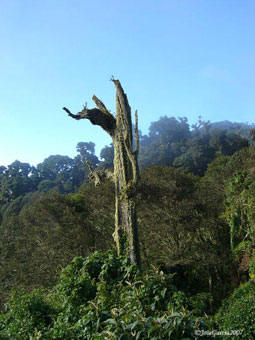 This famous trail goes through the Baru Volcano National Park and connects the towns of Cerro Punta and Boquete. This mountain rainforest is part of the Talamanca Mountain Range, an interesting geological formation that contains unique flora and fauna perfect to harbor highland species of Chiriqui.
This famous trail goes through the Baru Volcano National Park and connects the towns of Cerro Punta and Boquete. This mountain rainforest is part of the Talamanca Mountain Range, an interesting geological formation that contains unique flora and fauna perfect to harbor highland species of Chiriqui.
These absolutely beautiful forests have the highest peak in Panama, the Baru Volcano 11,398 ft. The Quetzales Trail goes to at an altitude of 6000 ft, on a ridge with amazing views, and full of ancient trees, like oak, cedar, magnolia and laurel or aguacatillo (Quetzals main food). Ferns and mosses provide habitat for a great number of birds, such as Buffy Tuftedcheek, Ruddy Treerunner, Spotted Barbtail, and Spectacled Foliage-Gleaner. Heliconias and flowers attract a variety of gorgeous hummingbirds such as White-throated Mountain-Gem, Fiery-throated Hummingbird, Volcano Hummingbird, Magnificent Hummingbird and Violet Sabrewing.
The Resplendent Quetzal, Prong-billed Barbet, Wrenthrush, White-naped Brush-Finch, Lange-footed Finch, Long-tailed Silky-flycatcher and Black-and-yellow Silky-flycatcher are some other of the avian specialties of the Chiriqui Highlands.
Baru Volcano National Park - Chiriqui Highlands
This park protects the Baru Volcano with 3,475 meters. From the top the two oceans are visible on a clear day. Temperature changes from 20°c in the lowest parts to less than 10°c at the top of the volcano. This park has one of the most beautiful trails in Panama, Los Quetzales Trail. This trail can be walked from Cerro Punta to Boquete or vice versa. Over 250 species of birds have been found here, among them, the beautiful Resplendent Quetzal. Birding the lower slopes of the volcano is very productive, being a place to find several endemism of the Talamanca Mountain Range like Black Guan and the Wrenthrush.
Birding Fortuna
This is one of the finest places in Panama to enjoy nature and peaceful birds. Located on the Western highlands of Panama, on the eastside of the Baru Volcano, this area is home of globally endangered species like the Bare-Necked Umbrellabird and Three-wattled Bellbird. The Fortuna forest is part of a hydro-electric plant in which 20 thousands hectares were set aside as a hydrographic basin for the artificial lake created for the project.
The fact that this region is located in the Western Mountain Range of the country, in which there is an easy access from the Pacific to the Continental Dived, and then a steep drop to the Caribbean slope, sets you in the perfect place to locate birds of different altitudes. The cloud forest of the area falls into the Western Highlands of Panama.
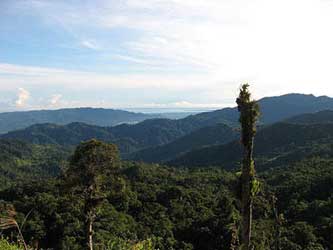
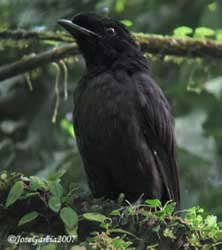
The area has different trails to explore but none of them is marked. At the continental divide area, just before the Bocas del Toro limit sign, turn left and go on a gravel road that turns right for 1km, on the left side of this gravel road, there is a steep bank and a trail that goes up on a high ridge. This trail is good to find Black-Guans, Three-wattle Bellbirds, White-bellied and Purple-throated Mountain-Gems, Golden-browed Chlorophonias, Rufous-breasted Antthrush, Blue-and-gold-Tanagers, Tree-striped Warbler, Lineated Foliage-Gleaner, Golden-olive Woodpeckers, Rufous-rumped Antwren, Bare-necked Umbrellabird and many other Tanagers.
This gravel road is good to find Blue-and-gold-Tanagers, Spangle-cheeked Tanagers and Silver-throated Tanagers. Tawny-capped Euphonias, Chlorophonias and Barred-Hawk, can be found on this area too. Umbrellas or rain jackets are essential for birding Fortuna, since this is a very wet area.
Bocas del Toro
Lower on the Caribbean Slope, driving away from the Continental Divide, on the Bocas del Toro Province you come across a sign on the left of the road that says Willi-Mazu. This is a private lodge, so you should make reservations before getting there. The place is located 500 meters above sea level and from the yard you can find a variety of tanagers of lower altitudes and higher altitudes too. This is a good place to find Rufous-wing Woodpecker, Black-capped Pygmy-Tyrant, Ashy-throated Bush-Tanager, Immaculate Antbird, Olive-back Euphonia as well as many warblers. The back yard hummers include Green-Thorntail, White-tipped Sicklebill , Green-crowned Brilliant and Bronzy Hermit among others.
On the main road more towards the Caribbean look for good forests with steep banks to find the Rufous-tailed Jacamar. High in the trees look for the Band-back Wren. Look around also for Pale-billed Woodpecker.
Chiriquí Grande
This is an interesting area to see some Western Caribbean lowlands species; it has an easy access, only 40 minutes from the Continental Divide. This is a remnant of forest next to the Oil Terminal Company (Two Tanks). Some special birds seen here are White-collared Seed-Eater, Great Antshrike, Green- Ibis, Chestnut-colored Woodpecker, White-crowned Parrot and Pale-billed Woodpecker.
Changuinola
Located on the extreme western Caribbean lowlands of Panama this town does not offer too much for ecotourism, except some splendid birds. Changuinola has its own domestic airport and is the starting point for an expedition to Teribe River and Bocas Islands.
The San-San Pond-Sak Wetlands are good to find the Black-throated Wren, Olive-throated-Parakeet, Olive-backed Euphonia, Grayish Saltator, Olive-back Yellow-Throat and Black-cowled Oriole. The Crimson-fronted Parakeet seem to be everywhere in town.


Teribe River/Weckso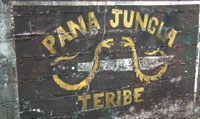 The upper basin of the Teribe River is considered one of the most remote eco-destinations in Panama, it is best reaches from the town of El Silencio. An hour boat ride will take you to the Teribe-Naso-Lodge; this is a community based Ecotourism Project run by The Weckso NGO.
The upper basin of the Teribe River is considered one of the most remote eco-destinations in Panama, it is best reaches from the town of El Silencio. An hour boat ride will take you to the Teribe-Naso-Lodge; this is a community based Ecotourism Project run by The Weckso NGO.
They have a nice 1 hour trail around the center good to find White-collared-Manakin, Northern Bentbill, Green-breasted Mango and Bronzy-Hermit among others. Going to the upper basin of the river will yield Great-green-Macaws and Perhaps a Harpy Eagle.
Birding Azuero
Western Pacific Lowlands
Las Macanas Marsh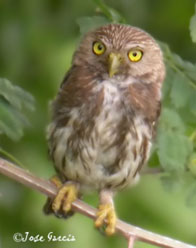
Located in the Central Provinces of Panama (Herrera) this is a superb wetland birding area. This marsh is a must stop if you are traveling by road on the Pan-American Highway in route to western Panama. The site is only 20 minutes away from the Pan-American highway. The nice feature of the site is a watch tower in front of the marsh excellent to admire or photograph the wetland wildlife. Black-bellied and Fulvous-bellied Whistling-Ducks fly back and forth, Snail Kites, Herons, Jacanas, and White-wing Doves following.
The nearby scrubs are good to find Pale-breasted Spinetail, Mouse-colored Tyrannulet, Plain-breasted Ground-Dove and Ferruginous Pygmy-Owl. Glossy Ibises and Lesser-yellow Headed Vultures are present too. Look at the open skies for White-tailed Kite and Aplomado Falcon.
Cerro Hoya


Birding El Cope
The forests above El Cope are located within the Omar Torrijos National Park, best known as El Cope National Park, the birdlife in this cloud forest is of top quality. Weather Conditions can be a problem in this area, especially during the months of January and February. If there is no fog up, the birding can be very productive. The cloud forest of the area falls into the easternmost range of the Western Highlands of Panama. There are several trails around the visitor center area.
The birdlife is very diverse, including birds of the Western foothills of Panama, such as Bay-headed, Speckled, Emerald and Silver-throated Tanager being fairly common. The Orange-bellied Trogon, Yellow-eared Toucanet, Immaculated Antbird, Purplish-backed Quail-Dove , Thrush-like Shiffornies and Stripe-breasted Wren are common. The rare Bare-necked Umbrellabird has been seen very few times, especially at the peak of the rainy season in Panama (September-October-November). Some others seen regularly are Smoky-brown Woodpecker, Streak-chested Antpitta, Black-crowned Antpitta, Yellow-throated Bush-Tanager and Spotted Barbtail. Some rare possibilities include Strong-billed Woodcreeper and Plumbeous Hawk.

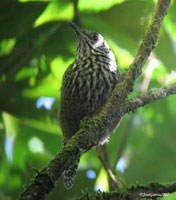
This is a place for hummingbird lovers; some of the most unique hummers are found in this region, the elusive Snowcap, Green Thorntail, Green-crowned Brilliant and White-tipped Sicklebill are present, as well as many other hermits. Most of these hummers are altitudinal migrants; Snowcaps are easier seen during the dry season; otherwise try to look for them bathing in the creeks in the mid morning.
Over the Valleys of the Mountains it is common to see the speedy White-collared Swifts flying low over the treeline. The open areas around the Continental Divide are good to see the Globally Threatened Red-fronted Parrolets flying almost at canopy level too.
"The forests of El Cope region are among the most beautiful in Panama and provide excellent birding." (Robert S. Ridgely)
These mountains have a great potential for birdwatching, but few birders have been there. We invite you to discover this new birding area and be part of the protection of this incredible reserve in Panama.